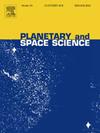线性推扫卫星图像动态定位系统误差的一般补偿方法
IF 1.7
4区 物理与天体物理
Q3 ASTRONOMY & ASTROPHYSICS
引用次数: 0
摘要
在地球观测和行星探测任务中,通过遥感进行高精度地理定位至关重要。然而,由于传感器的限制和测量技术的限制,卫星图像和辅助飞行数据中的动态系统误差对传统的定向图像模型和偏置补偿模型等校正方法提出了挑战。本文提出一种分段偏置矩阵补偿方法,通过有效消除动态系统误差,提高线性推扫帚相机的地理定位精度。该方法主要利用动态系统误差引起的重投影残差的分布特征来检测定向点曝光时间。这是通过一种涉及残差点云细化和迭代终点拟合算法的逐步策略来实现的,该策略自动划分子补偿模型。此外,考虑到卫星飞行姿态的稳定性,在分段偏置矩阵补偿模型中引入拉格朗日插值方法,提高了光学线性推扫帚卫星几何定位过程中的内部一致性和绝对精度。对比实验数据集的初始相机定位结果表明,MEX-HRSC中共轭点的重投影误差可以达到亚像素级精度,最大均方根误差为0.54像素;XX-18的gcp重投影误差现在可以达到亚像素精度,最大均方根误差为0.80像素。此外,在消除动态系统误差的基础上,本研究利用MEX-HRSC的高分辨率立体图像构建了火星表面的高空间分辨率dtm。这些技术和方法使相应的射线在立体对中相交,这对后续的三维重建至关重要。本文章由计算机程序翻译,如有差异,请以英文原文为准。
A generic compensation method for dynamic systematic errors in the geolocation of linear pushbroom satellite imagery
In Earth observation and planetary exploration missions, high-precision geolocation through remote sensing is crucial. However, dynamic systematic errors in satellite imagery and ancillary flight data, arising from sensor limitation and measurement technology, challenge traditional correction methods such as orientation image model and bias compensation model. This study proposes a piecewise bias matrix compensation method to improve the geolocation accuracy of linear pushbroom cameras by effectively eliminating dynamic systematic errors. The method focuses on detect orientation point exposure time utilizing the distribution characteristics of the reprojection residuals caused by dynamic system errors. This is accomplished through a stepwise strategy involving residual point cloud thinning and iterative end-point fitting algorithms, which automatically divide the sub-compensation model. Furthermore, considering the stability of the satellite’s flight attitude, a Lagrange interpolation method is introduced in the piecewise bias matrix compensation model, enhancing the internal consistency and absolute accuracy in the geometric positioning process of the optical linear pushbroom satellite. A comparison of the initial camera positioning results in the experimental dataset revealed that the reprojected errors of conjugate points in the MEX-HRSC can now achieve sub-pixel accuracy, with a maximum root mean square error of 0.54 pixels; the reprojected errors of GCPs in the XX-18 can now achieve sub-pixel accuracy, with a maximum root mean square error of 0.80 pixels. Additionally, building upon the elimination of dynamic systematic errors, this study constructs high spatial resolution DTMs of the Martian surface using high-resolution stereo imagery from the MEX-HRSC. These techniques and methods result in the intersection of corresponding rays in stereo pairs, which is crucial for subsequent 3D reconstruction.
求助全文
通过发布文献求助,成功后即可免费获取论文全文。
去求助
来源期刊

Planetary and Space Science
地学天文-天文与天体物理
CiteScore
5.40
自引率
4.20%
发文量
126
审稿时长
15 weeks
期刊介绍:
Planetary and Space Science publishes original articles as well as short communications (letters). Ground-based and space-borne instrumentation and laboratory simulation of solar system processes are included. The following fields of planetary and solar system research are covered:
• Celestial mechanics, including dynamical evolution of the solar system, gravitational captures and resonances, relativistic effects, tracking and dynamics
• Cosmochemistry and origin, including all aspects of the formation and initial physical and chemical evolution of the solar system
• Terrestrial planets and satellites, including the physics of the interiors, geology and morphology of the surfaces, tectonics, mineralogy and dating
• Outer planets and satellites, including formation and evolution, remote sensing at all wavelengths and in situ measurements
• Planetary atmospheres, including formation and evolution, circulation and meteorology, boundary layers, remote sensing and laboratory simulation
• Planetary magnetospheres and ionospheres, including origin of magnetic fields, magnetospheric plasma and radiation belts, and their interaction with the sun, the solar wind and satellites
• Small bodies, dust and rings, including asteroids, comets and zodiacal light and their interaction with the solar radiation and the solar wind
• Exobiology, including origin of life, detection of planetary ecosystems and pre-biological phenomena in the solar system and laboratory simulations
• Extrasolar systems, including the detection and/or the detectability of exoplanets and planetary systems, their formation and evolution, the physical and chemical properties of the exoplanets
• History of planetary and space research
 求助内容:
求助内容: 应助结果提醒方式:
应助结果提醒方式:


